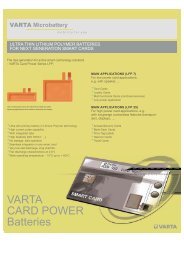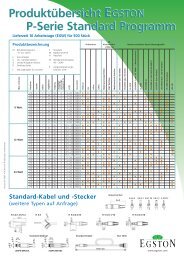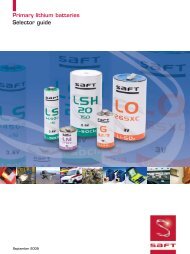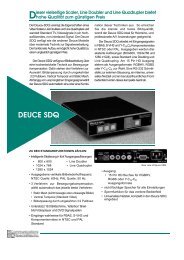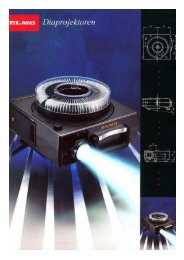BATTERY CHARGERS DIAGNOSTIC TOOLS BATTERY TESTERS
BATTERY CHARGERS DIAGNOSTIC TOOLS BATTERY TESTERS
BATTERY CHARGERS DIAGNOSTIC TOOLS BATTERY TESTERS
Create successful ePaper yourself
Turn your PDF publications into a flip-book with our unique Google optimized e-Paper software.
<strong>BATTERY</strong> <strong>CHARGERS</strong> - <strong>TESTERS</strong> - <strong>DIAGNOSTIC</strong> <strong>TOOLS</strong><br />
Important OptiMate facts<br />
1 : Why do batteries become sulfated?<br />
TecMate has worked with OEs such as Honda, Yamaha, Suzuki, Kawasaki, Yuasa and East Penn Manufacturing<br />
in learning why batteries sulfate & how to recover batteries from a deep discharged, sulfated condition.<br />
We confi rmed the following:<br />
When a battery is discharged, the sulphuric ‘battery’ acid separates into lead sulfate and water. When batteries<br />
are left in a discharged state for too long sulfate crystals will form on the lead plates, increasing the electrical<br />
resistance of the battery. The higher the concentration of sulfate crystals the higher the electrical resistance<br />
which typically prevents current from being accepted by the battery at normal charge voltages (14,1 to 14,5V).<br />
In winter the water separated from the acid in a discharged battery freezes at temperatures below 32°F / 0°C.<br />
When water freezes it expands resulting in bent & buckled plates or a cracked casing.<br />
Heat is a big killer of lead-acid batteries. At high temperature water evaporates, increasing the concentration<br />
of lead sulfate which speeds up the formation of sulfate crystals. At some point the concentration of sulfate<br />
crystals may become so high that permanent electro-mechanical damage (plates being short circuited) is<br />
caused inside the battery.<br />
2 : Why can OptiMate recover sulfated batteries that other smart chargers cannot?<br />
If a standard smart charger that typically charge up to 14,1 to 14,5V is hooked up to a sulfated battery the<br />
voltage will immediately rise from a very low level (typically less than half the battery voltage) to the maximum<br />
as the charger ‘sees’ the sulfated battery as a full battery due to it’s higher than normal internal resistance.<br />
Current into the battery remains in the micro amp range, too low to reverse the sulfation process. A standard<br />
charger will indicate within seconds that the battery is fully charged and some may indicate the battery is faulty<br />
and should be replaced.<br />
OptiMate has a smarter charging method that fi rst detects condition of a battery and then it decides how to<br />
charge it. It starts with forcing a small current pulse into the battery to see if the battery accepts charge. If not,<br />
then OptiMate engages the DESULFATE mode and now the charging voltage is allowed up to a maximum of<br />
22V in an attempt to force the battery to accept current. Usually within 5 minutes a battery with a chance at<br />
recovery will begin to accept current, causing the sulfate crystals to disolve and combine with water remaining<br />
in the battery to again form high concentrate acid. If the OptiMate determines that the battery has recovered<br />
suffi ciently it will increase the charge current and the program will advance to bulk, cell balancing and verifi cation<br />
charging.<br />
3 : How would I know if OptiMate has successfully recovered a sulfated battery?<br />
The fi nal charge stage of the OptiMate program is followed by a charge retention test to confi rm if the battery<br />
has been adequately recovered. Indication of the result ranges from basic to comprehensive, depending on<br />
the OptiMate model in use.<br />
4 : Why do sealed AGM batteries recover from sulfation more effectively than fi ller cap / wet cell<br />
batteries?<br />
In sealed AGM batteries the water remains absorbed in the fi breglass mat separators whilst the lead sulfate<br />
remain on the plates. Due to this sulfation will occur at a faster pace on the plates itself compared to wet cell /<br />
fi ller cap batteries, but the water will not evaporate out of the sealed battery as it would with wet cell / fi ller cap<br />
batteries. AGM batteries therefore have a much higher chance of full recovery even if the battery has been<br />
left discharged for many months. The OptiMate charging method works best with AGM batteries, but will also<br />
recover fi ller cap / wet cell batteries that have not suffered visible mechanical damage (e.g. bulging or cracked<br />
case) or high loss of electrolyte.<br />
The degree of effectiveness of the recovery depends on how soon after the battery became sulfated is it<br />
hooked up to an OptiMate. We have letters on fi le from a number of OptiMate users testifying to effective<br />
recovery of batteries left discharged (and believed to be dead) for two years.<br />
5 : Can OptiMate’s high voltage desulfation mode damage vehicle electronics ?<br />
The simple answer is NO. A sulfated battery’s voltage will initially be in the 2 to 6V range. Vehicle electronics<br />
need 11V or more before current is drawn. Upon connection OptiMate will attempt to deliver current causing<br />
T: 905 337 2095 F: 905 337 3962 sales@tecmate.com<br />
5





